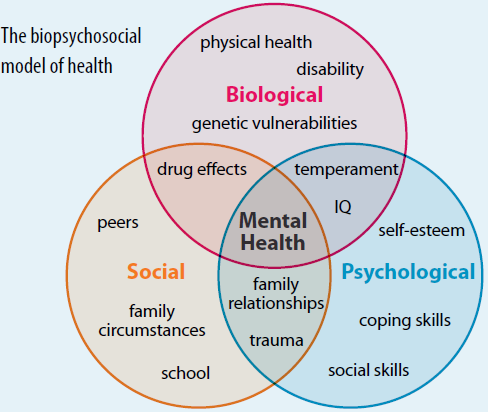Determinants of Health
Original Editor - Rachael Lowe
Top Contributors - Rachael Lowe, Wendy Walker, Naomi O'Reilly, Laura Ritchie, Kim Jackson, Jess Bell, Rucha Gadgil, Robin Tacchetti, Tarina van der Stockt, Vidya Acharya, Shaimaa Eldib and Carin Hunter
Introduction[edit | edit source]
"Health care is an important determinant of health. Lifestyles are important determinants of health. But... it is factors in the social environment that determine access to health services and influence lifestyle choices in the first place." WHO Director-General Dr Margaret Chan[1]
Many factors combine together to affect the health of individuals and communities. Whether people are healthy or not, is determined by their circumstances and environment. To a large extent, factors such as where we live, the state of our environment, genetics, our income and education level, and our relationships with friends and family all have considerable impacts on health, whereas the more commonly considered factors such as access and use of health care services often have less of an impact.
Determinants of health[edit | edit source]
The range of personal, social, economic, and environmental factors that influence health status are known as determinants of health.
These can be classified as:
- the social and economic environment,
- the physical environment, and
- the person’s individual characteristics and behaviours.
The Office of Disease Prevention and Health Promotion (ODPHP) has broadly categorised the determinants of health[2]:
- Policymaking
- Social factors
- Health services
- Individual behaviour
- Biology and genetics
Social Factors[edit | edit source]
The ODPHP describes social determinants of health reflect the social factors and physical conditions of the environment in which people are born, live, learn, play, work, and age. Also known as social and physical determinants of health, they impact a wide range of health, functioning, and quality-of-life outcomes.
Examples of social determinants include:
- Availability of resources to meet daily needs, such as educational and job opportunities, living wages, or healthful foods
- Social norms and attitudes, such as discrimination
- Exposure to crime, violence, and social disorder, such as the presence of trash
- Social support and social interactions
- Exposure to mass media and emerging technologies, such as the Internet or cell phones
- Socioeconomic conditions, such as concentrated poverty
- Quality schools
- Transportation options
- Public safety
- Residential segregation
Examples of physical determinants include:
- Natural environment, such as plants, weather, or climate change
- Built environment, such as buildings or transportation
- Worksites, schools, and recreational settings
- Housing, homes, and neighborhoods
- Exposure to toxic substances and other physical hazards
- Physical barriers, especially for people with disabilities
- Aesthetic elements, such as good lighting, trees, or benches
Poor health outcomes are often made worse by the interaction between individuals and their social and physical environment.
Social and economic environment determinants of health[edit | edit source]
The social determinants of health are the conditions in which people are born, grow, live, work and age. These circumstances are shaped by the distribution of money, power and resources at global, national and local levels. The social determinants of health are mostly responsible for health inequities - the unfair and avoidable differences in health status seen within and between countries. Health inequities are unjust and avoidable. In order to reduce health inequities, there is a need to address the wider socioeconomic and structural factors that influence how people become sick, what risk factors they are exposed to, how they access services, and how they use those services.
Based on social and environmental conditions in which people live. According the to World Health Organisation the 9 social determinants of health are:
- Stress
- Early life
- Social exclusion
- Work
- Employment
- Social support
- Addiction
- Food
- Transport
Relevance to Physiotherapy[edit | edit source]
In our contact time with our patients we spend a lot of time understanding thier health and social status, in other words we explore and determinants that might be affecting their health, and in particular ones that we can influence. The model we use to analyse and understand these determinants of health is the biopsychosocial model of health care.
Resources[edit | edit source]
References[edit | edit source]
- ↑ Dr Margaret Chan. Launch of the final report of the Commission on Social Determinants of Health. 2008. Accessed online 6 January 2017.
- ↑ Office of disease prevention and health promotion. Determinants of Health. Accessed online 6 January 2017.







